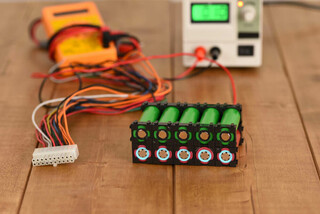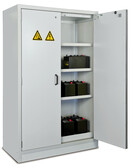The demand for lithium-ion batteries is growing by the day, and affects areas ranging from electronics to renewable energy. In practice, this means that there is a need for effective and safe storage of this type of battery. Lithium-ion batteries require the right storage conditions to ensure safety and their optimum service life. As batteries are found in many of the products that surround us, lithium-ion battery storage cabinets are becoming an increasingly desirable and expected part of reality – whether in factories, companies or sometimes even in homes. We will take a closer look at lithium-ion battery storage cabinets and their key features and functions in this article.
Introduction to the topic
Lithium-ion batteries are highly efficient energy carriers that are ideally suited to a wide range of applications. They are becoming an increasingly popular power source because of their advantages. They have a high energy density and a low self-discharge rate, and lack the memory effect. Lithium-ion batteries can be dangerous, especially if they are improperly stored or exposed to extreme conditions. It is therefore extremely important to take proper precautions when storing them.
Given the increasing demand for energy, its storage is of particular importance. This means that the demand for high-capacity batteries will also increase steadily.
There are several causes that can lead to the ignition of batteries. These include:
• overheating when charging lithium batteries,
• use of incorrect chargers or overcharging,
• deep discharge,
• mechanical damage,
• high ambient temperature.
And where are lithium-ion batteries most commonly used in our environment?
• In increasingly popular electric bicycles or electric scooters,
• in gardening tools such as lawn robots,
• in consumer electronics – as lithium-ion batteries are among the lightest (of those available on the market), they are mainly used in all kinds of electronic equipment: laptops, tablets, smartphones, digital cameras and even electric toothbrushes,
• in power tools.
The role of lithium-ion battery storage cabinets
Lithium-ion battery storage cabinets play a key role in ensuring safety and optimal storage conditions. The main functions of the cabinets are:
• fire safety: lithium-ion battery storage cabinets are designed to prevent fires and minimize the risk of fire spreading. They are made of high-quality fire-resistant materials. They have certificates indicating the level of fire protection from the inside (should a fire ignite the batteries stored inside the cabinet) and from the outside (should a fire occur in the building in which the cabinet is installed),
• ventilation: they are equipped with an adequate ventilation system that allows the removal of potentially dangerous gases and vapours emitted by the batteries. This helps maintain optimum temperature conditions and protects against overheating of the batteries,
• shock and mechanical resistance: the cabinets are constructed from robust materials and thus protect the batteries from shocks, falls or other mechanical damage,
• labelling and identification: the cabinets should be appropriately labelled to clearly indicate that lithium-ion batteries are stored in them. This facilitates identification and awareness of those around them.
Rules for storing lithium-ion batteries in cabinets
When it comes to storing lithium-ion batteries in cabinets, there are a few key rules to follow:
• separate storage of batteries and other items: batteries should be stored separately from other materials, such as flammable chemicals, paper or other materials. Being careful in this regard helps to reduce the risk of fire or a hazardous chemical reaction occurring.
• restriction of access: only properly trained and authorised persons should have access to the lithium-ion battery cabinet. Such persons should have knowledge of safety rules and how to deal with emergencies.
• temperature and humidity: the cabinet should be installed in a temperature and humidity controlled room. High temperature or humidity can shorten battery life and increase the risk of failure, so batteries should be stored at the temperature recommended by the manufacturer. Both too high and too low values can adversely affect battery performance and safety.
• mechanical damage: lithium batteries should not be subjected to strong shocks, falls or mechanical damage. These can lead to dangerous leakage of chemicals.
Products for lithium-ion batteries available from Hartmann Tresore
HTG 088-01.Li, HTG 089-01.Li (1- or 2-door) – these are storage cabinets for type 90 batteries – with a fire resistance of 90 minutes in accordance with the European Standard EN 14470-1 [fire test according to EN 1363-1 Resistance to external fire]. In terms of equipment, each cabinet has 3 bath shelves (adjustable in height) and a sump at the very bottom. The cabinets are equipped with a hydraulic self-closing device – in the event of a temperature rise (fire), the door and the air inlet and ventilation openings close automatically. It is possible to connect the cabinets to a ventilation system (integrated into the building) or to use a special extension – connecting an external exhaust unit.
HTG 091-01.Li (2-door) – is a cabinet designed for smoke-proof and fire-proof storage of lithium-ion batteries (fire protection from the inside and outside). The cabinet is equipped as standard with a ventilation system (it has a fan and a smoke detector) in the rear panel and cable feed-throughs at the top and bottom. The cabinet has a fire seal around the door, swelling in the event of a fire. Power strips (used to charge batteries inside the cabinet) can be installed in the cabinet.
All cabinets have a cylinder lock. The construction of the cabinets is very robust.
Summary
Storage and charging cabinets for lithium-ion batteries play a key role in ensuring the safe and efficient deposition of these batteries. Adherence to appropriate storage practices, such as separate storage, temperature and humidity control and the use of safety practices, is essential to maintain the safety and optimum performance of the batteries. It is also important to regularly monitor and maintain the cabinets to ensure they meet requirements and provide effective protection. It is worth remembering the importance of educating staff to raise awareness of lithium-ion battery storage and minimise the risk of failure.
Is proper storage and care of batteries only relevant when they are found in business (manufacturing companies, offices)? Definitely no. Individuals are also concerned about their safety – a battery storage cabinet was recently purchased by a drone enthusiast. Understanding and following storage policies and practices will help keep batteries in optimal condition for longer and minimise the risk of failure. According to news reports on 27 June 2023 in Tychy (Silesia), a dangerous incident occurred in one flat – a battery in an electric scooter exploded and the explosion destroyed the flat.
Li-ion and lithium battery cabinets are created to keep people and goods safe. Batteries have the peculiarity of posing a number of hazards, the most well-known and most common of which is an uncontrolled rise in temperature, which can result from an increase in ambient temperature, a shock or a problem with the installation of the battery. The consequence is that the battery can dangerously catch fire and cause a fire.
Based on our experience and know-how in the field of fire cabinets compliant with European Standard EN14470-1, 90-minute version, we offer several models of different sizes that can meet the most varied battery storage needs. There is something to suit everyone.
Read other publications:





